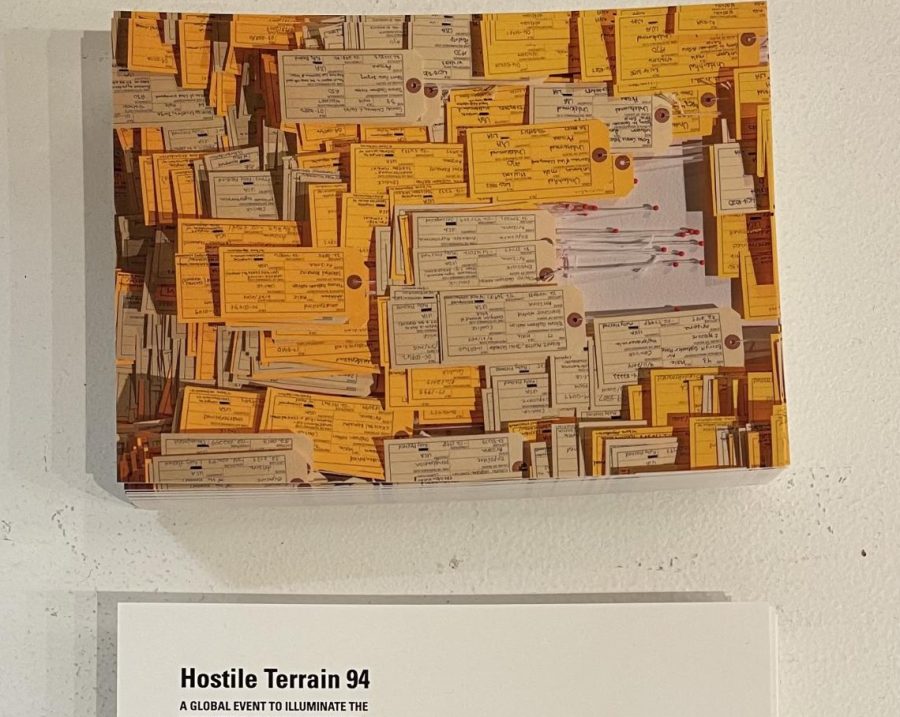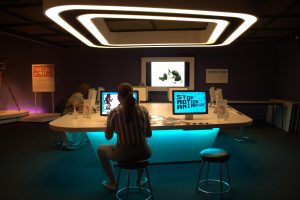Hostile Terrain 94: A Moment of Awareness
The exhibit ‘A Migrant’s Journey: Hostile Terrain Interactive Reflection’ commemorates lives lost and shows the truth behind immigration laws in the United States
The Hostile Terrain exhibit depicts the Arizona-Mexico border filled with over 3,200 toe tags to represent those who died crossing the border.
November 9, 2021
CORRECTION: A previous version of this article misstated Carey Kasten to be a Latin American and Latino studies and comparative literature professor. As of Nov. 12, 2021, this article has been updated to reflect that Carey Kasten is an associate professor of Spanish.
In 1994, the United States Border Patrol formally established an immigration enforcement strategy they called “Prevention Through Deterrence” (PTD). According to the Hostile Terrain 94 official website, this policy was designed to discourage undocumented immigrants from crossing the U.S.-Mexico border.
The United States Border Patrol closed off urban points of entry, forcing immigrants to cross the border through hostile terrain, deserts and depopulated areas. More than six million people have attempted to cross the border through places like the Sonoran Desert in Arizona. At least 3,200 people have died.
This is where Hostile Terrain 94 — an installation started by the Undocumented Migration Project in 2009, which is currently showing as an art exhibit at the Lipani Gallery at Fordham Lincoln Center (FLC) — comes in.
The Fordham community has been filling out tags to help mount this exhibit.
Originally scheduled to open in fall 2020 but delayed because of COVID-19, the Hostile Terrain exhibition at FLC is both simple and complicated. The installation will be shown at Rose Hill next semester, depicts a map of the Arizona-Mexico border filled with over 3,200 toe tags — identification tags attached to the toe of a deceased person.
These toe tags, colored white for identified remains and orange for unidentified remains, represent the recovered bodies of those who have died trying to cross the U.S.-Mexico border. Through these tags, viewers see the reality of the situation that has been imposed on those who want a better life.
Over the past few weeks, the Fordham community has been filling out tags to help mount this exhibit. Students in class and in their free time have joined faculty members to learn about the harsh conditions that immigrants have been forced to endure and to raise awareness about the situation that the United States Border Patrol has created.
Different universities and art institutes throughout the U.S. have put up similar installations to commemorate the lives that have been lost in this journey.
Each toe tag includes the name, age, sex, cause of death, condition of body and location of recovery for each individual. They are physical markers of the suffering that these migrants endured. Every single toe tag on the wall represents someone who dared to make the journey and every single day that number increases.
Carey Kasten, an associate professor of Spanish at Fordham College at Lincoln Center, was one of the main contributors to this exhibition and gave insight into the importance and technicalities behind it.
“What the law Prevention Through Deterrence said was, ‘We’re going to push people away from the ports of entry. We’re gonna push people away from cities like Ciudad Juárez, El Paso, and Tijuana,’” Kasten explained. “All of a sudden, these places were very heavily patrolled and militarized.”
Kasten explained that this law pushed people toward the desert, and knowing that it was such a hostile terrain, they would then choose not to cross the border. In a way, it told those who sought asylum, “don’t come here.”
“What they’re fleeing from is worse than the experience of crossing the desert,” she said. “That’s what this particular exhibit is about: It’s about the U.S. Border Policy because that 1994 law is still the main policy that is in place today to patrol that border,” Kasten concluded.
Different universities and art institutes throughout the U.S. have put up similar installations to commemorate the lives that have been lost in this journey, to create awareness about the PTD law and what it may cause, and to immortalize the ones who tried.
This installation creates a space of commemoration, reverence and healing for those who have risked their lives in an attempt to better their environment. Standing in front of “A Migrant’s Journey: Hostile Terrain Interactive Reflection” is like being surrounded by silent screams, and that is purposeful. It’s painful, and at times discomforting, but it’s a reality that needs to be known and changed. This exhibit’s presence at FLC brings awareness of this reality to the Fordham community.














